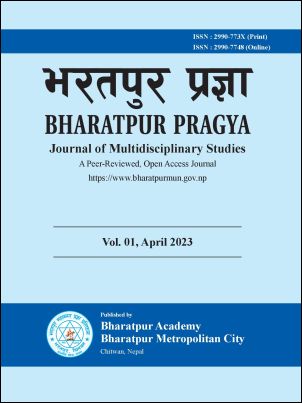A Study of Climate Change and Meteorological Analysis in Different Ecological Regions of Nepal
DOI:
https://doi.org/10.3126/bpjms.v1i1.55499Keywords:
Climate Risk, Vulnerability, Assessment, NepalAbstract
Climate change is caused by the increase of greenhouse gas emissions and the associated vulnerability is affecting the whole earth system. The climatic vulnerability has three components; exposure, sensitivity and adaptive capacity. The vulnerability is expressed in term of an index, ranging from 0-1. The inclusion of Climate Risk and Vulnerability (CRV) could be used for the analysis of potential impacts of climate change. CRV is a tool to adapt the climate change impacts in the areas all aspects of environment. Since, it is identified that one of the main component which is severely affected by the climate change is the Water source and water induced extreme events. It is known that when sensitivity is higher, the vulnerability tends to be high unless the adaptive capacity neutralizes the effects; wealth and social factors play a great role in enhancing adaptive capacity. Because of the uneven nature of the climatic factors, the effect of vulnerability also tends to be uneven. Adaptive capacity is an adjustment to reduce the adverse effects of climate change and enhance the benefits of it. The natural system takes its own course, but human intervention such as mitigations measures supports the natural process of adaptation. Nepal’s Contribution to Global GHG is minimum, however, the effect of climate change is severe such as increasing, landslide, GLOF, flood, and erosion; all affecting the life of the people. In spite of these, Nepal has not initiated any programs to address the issues, but upon the formulation of Climate Change Policy (2011), some actions were initiated to combat with Climate change hazards through the Ministry of Forest and Environment and related agencies of the government in collaboration with international agencies. Nepal has participated in the different series of COP and integrated provisions of UNFCCC in National Development Plan and in constitution of Nepal, and signed the provisions of UNFCCC in 1994 as a party to it, and prepared initial national communication in 2004 by which CDM implementation was made mandatory for cleaner Production.
Downloads
Downloads
Published
How to Cite
Issue
Section
License
Copyright (c) 2023 Navaraj Pokharel

This work is licensed under a Creative Commons Attribution-NonCommercial 4.0 International License.
CC BY-NC This license allows reusers to distribute, remix, adapt, and build upon the material in any medium or format for noncommercial purposes only, and only so long as attribution is given to the creator.




